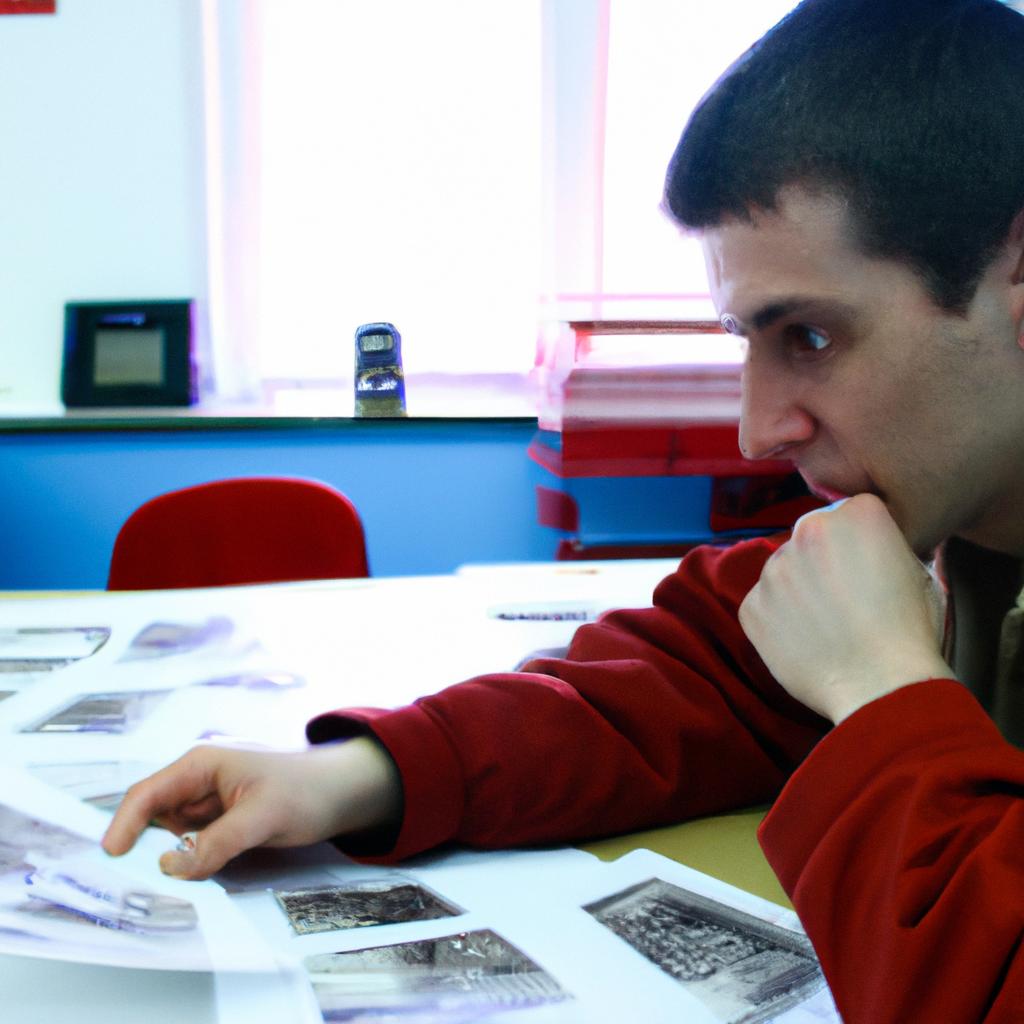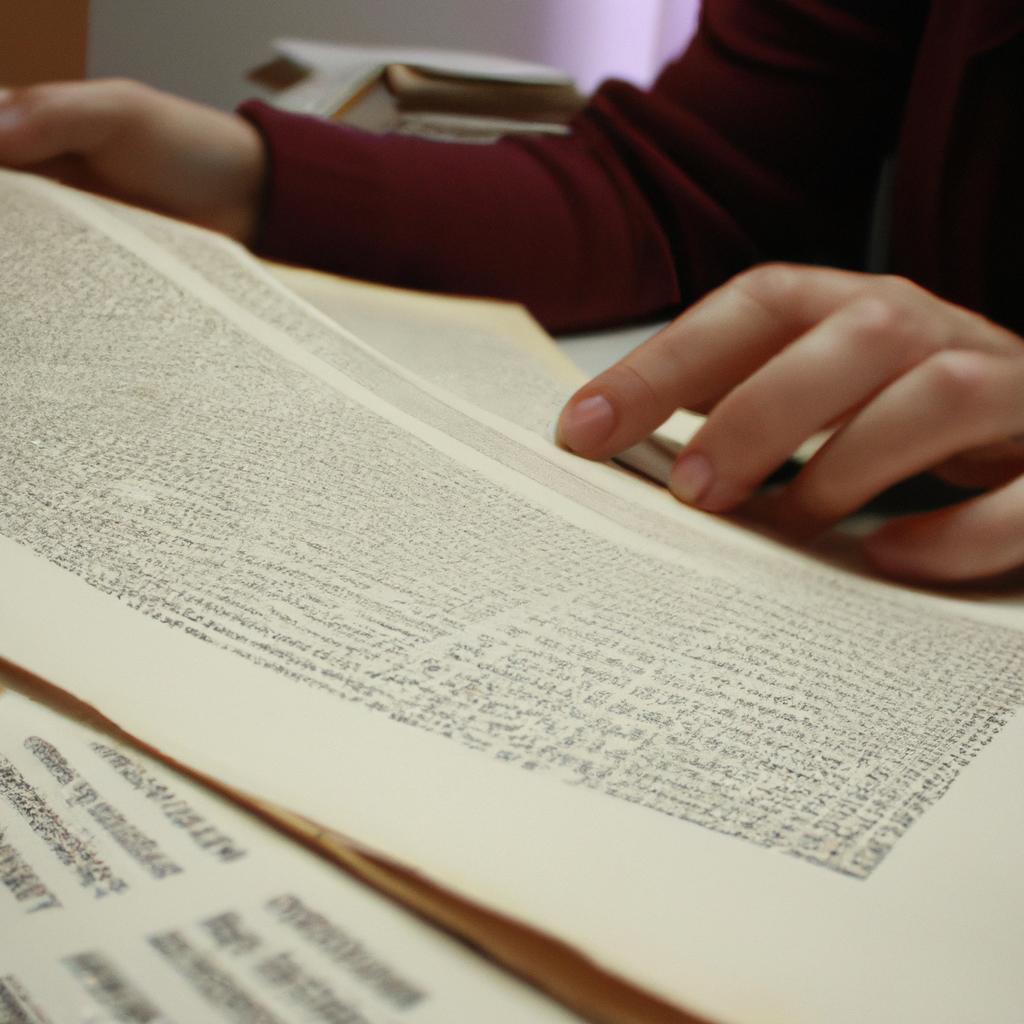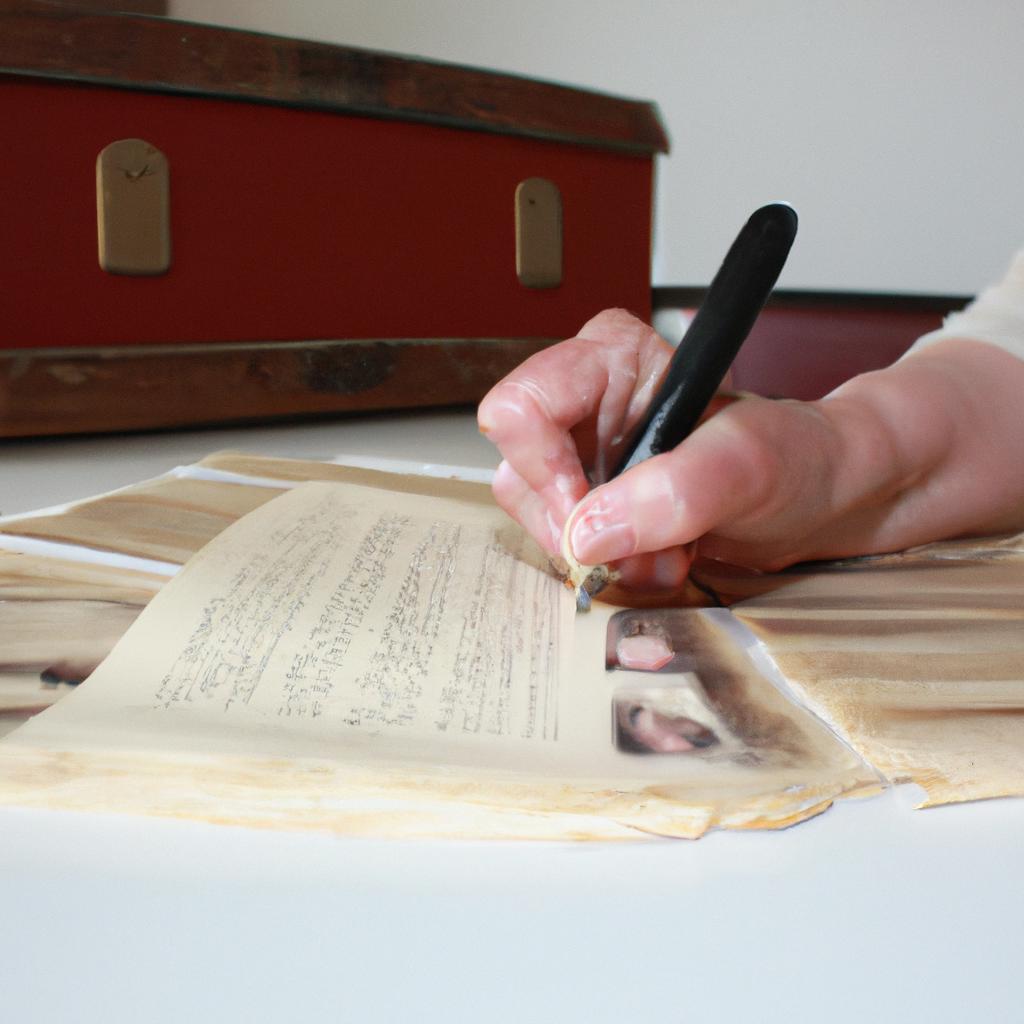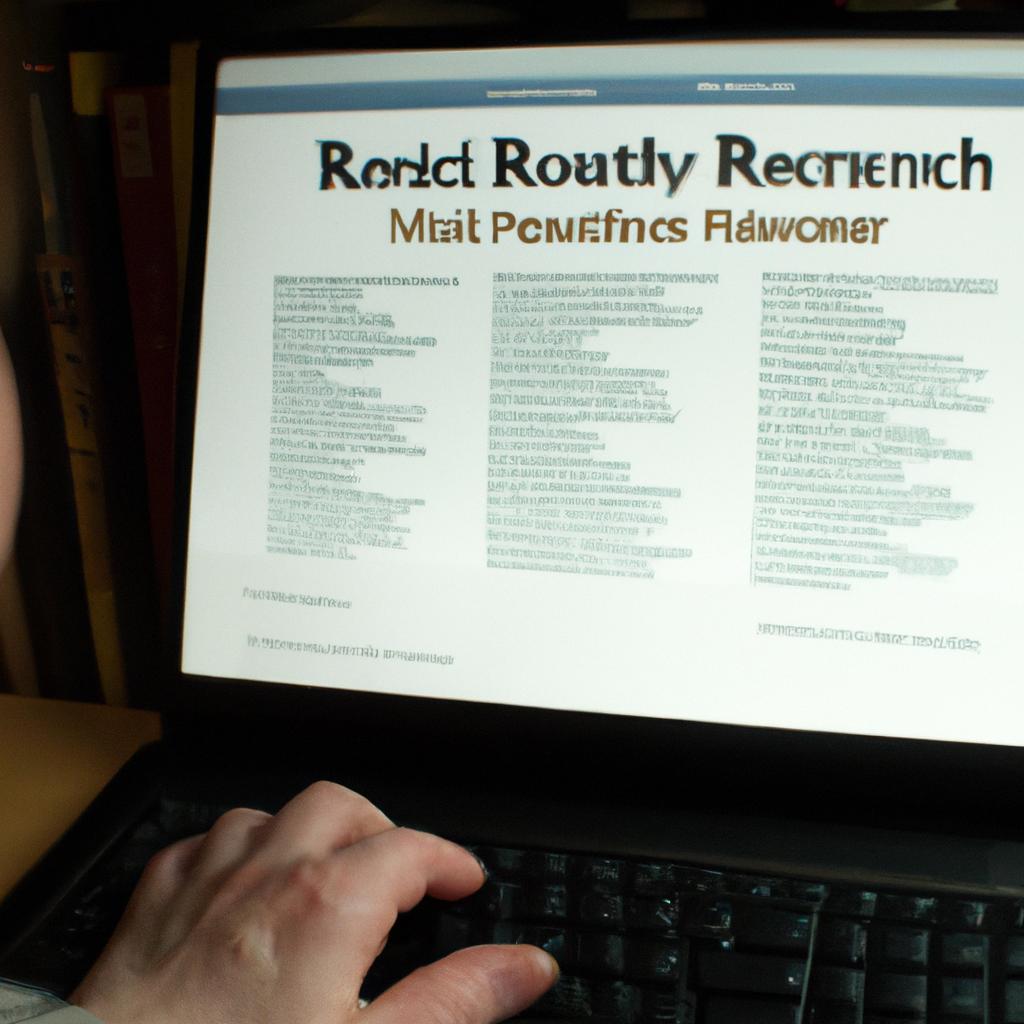Secondary sources play a crucial role in genealogy education, as they provide valuable insights and analysis of primary source materials. Through the process of source analysis, genealogists can gain a deeper understanding of their ancestors’ lives and uncover hidden connections within their family tree. This article aims to explore the significance of secondary sources in genealogy education and highlight how source analysis can enhance one’s research outcomes.
To illustrate the importance of secondary sources, let us consider an example involving a hypothetical researcher named Sarah who is tracing her family history. Sarah comes across a birth certificate for her great-grandfather, but it only provides limited information about his parents. Frustrated by this lack of detail, she turns to secondary sources such as census records, obituaries, and local histories to gather more comprehensive data. By carefully analyzing these secondary sources alongside the primary document, Sarah discovers additional details about her great-grandfather’s life – including his occupation, residence, and familial relationships that were not mentioned on the birth certificate alone.
Understanding how to effectively analyze secondary sources is essential for any aspiring genealogist. By critically evaluating these resources for accuracy, bias, and relevance to their research goals, individuals can avoid potential pitfalls or inaccuracies that may arise from relying solely on primary sources. Additionally, secondary sources can provide context and background information that primary sources may not offer. For example, a local history book might provide insights into the social and cultural aspects of a particular time period or region, shedding light on the lives of individuals and families within that context.
Source analysis in genealogy involves comparing and cross-referencing multiple secondary sources to corroborate information and identify discrepancies. This process helps researchers build a more comprehensive and accurate picture of their ancestors’ lives. By examining different perspectives and accounts, genealogists can uncover new leads, verify existing information, or even challenge previously accepted assumptions about their family history.
Furthermore, secondary sources can fill in gaps where primary sources are either missing or incomplete. For instance, if vital records for a specific time period are not available or have been destroyed, newspaper articles or church records from that era could potentially provide valuable details about births, marriages, or deaths.
In conclusion, secondary sources are invaluable resources in genealogy education. They enhance research outcomes by providing additional information, context, and analysis that complement primary source materials. Through careful source analysis and cross-referencing, genealogists can gain a deeper understanding of their ancestors’ lives while avoiding potential inaccuracies or biases inherent in any single source.
Understanding the Importance of Secondary Sources in Genealogy
Genealogical research relies heavily on the use of various sources to piece together family histories. Primary sources, such as birth certificates and marriage records, hold significant value due to their direct connection to individuals or events. However, secondary sources also play a crucial role in genealogy by providing additional context and interpretation of primary source information. This section aims to highlight the importance of secondary sources in genealogy and how they contribute to a more comprehensive understanding of one’s family history.
To illustrate this point, let us consider an example where a researcher is trying to trace back their ancestors from the 19th century. While primary sources like census records provide names and dates, they may not reveal the full story behind certain relationships or unforeseen circumstances that affected families during that time period. By consulting secondary sources such as historical newspapers or personal diaries, researchers can uncover valuable insights into social dynamics, economic conditions, and even local traditions that influenced their ancestors’ lives.
Secondary sources offer unique perspectives that enhance our understanding of historical events and personal narratives. They often serve as bridges connecting multiple generations, helping us establish connections between distant relatives who might have otherwise remained unknown. Furthermore, these sources can shed light on societal norms and cultural practices prevalent during specific periods – offering glimpses into customs and traditions handed down through generations.
In recognizing the significance of secondary sources in genealogy education, it is important to acknowledge their emotional impact on researchers. The knowledge gained from these sources has the power to evoke strong emotions – excitement when discovering new details about one’s heritage or empathy when learning about hardships endured by previous generations. To further emphasize this point, here is a bullet-point list showcasing potential emotional responses:
- A sense of belonging: Discovering shared experiences with ancestors fosters a deeper connection to one’s roots.
- Curiosity ignited: Uncovering hidden stories can spark intrigue and motivate further exploration.
- Empathy and understanding: Learning about the challenges faced by ancestors helps us appreciate their resilience.
- Pride in heritage: Discovering notable achievements or contributions made by family members can instill a sense of pride.
Additionally, an emotional response can be evoked through the following table that showcases different types of secondary sources and their potential impact:
| Secondary Source | Impact on Researchers |
|---|---|
| Personal memoirs | Deepens personal connection to ancestors |
| Oral histories | Preserves family traditions and cultural knowledge |
| Historical photographs | Provides visual representation of past lives |
| Biographical accounts | Illuminates individual stories within a broader historical context |
In conclusion, secondary sources hold immense value in genealogy research as they provide additional layers of information beyond what primary sources offer. By incorporating these sources into our investigations, we gain a more comprehensive understanding of our family’s history, enabling us to connect with previous generations on both intellectual and emotional levels. In the subsequent section, we will delve deeper into exploring various types of secondary sources available for genealogical analysis.
Exploring Different Types of Secondary Sources
Section H2: Understanding the Importance of Secondary Sources in Genealogy
Section H3: Exploring Different Types of Secondary Sources
Secondary sources play a crucial role in genealogical research by providing valuable information about individuals and families. These sources come in various forms, each offering unique insights into our ancestors’ lives. By exploring different types of secondary sources, researchers can gain a more comprehensive understanding of their family history.
One example that highlights the importance of diverse secondary sources is the study of census records. While official government records are considered primary sources, they also serve as valuable secondary sources when used to analyze demographic trends or compare data across multiple years. By examining census records alongside other secondary sources like newspaper articles or personal diaries, researchers can paint a richer picture of their ancestors’ experiences during specific time periods.
When utilizing secondary sources for genealogical research, it is important to consider their reliability and accuracy. To assist researchers in this process, here are four key factors to evaluate:
- Provenance: Assessing where the source originated from and who created it can provide insight into its potential biases or motivations.
- Consistency: Comparing information from multiple secondary sources can help identify any discrepancies or inconsistencies that may arise.
- Corroboration: Cross-referencing findings with primary sources whenever possible strengthens the credibility and reliability of the information obtained.
- Expertise: Considering the expertise and qualifications of those responsible for creating or analyzing the secondary source ensures greater confidence in its accuracy.
Table 1 below illustrates how different types of secondary sources complement one another by offering distinct perspectives on an individual’s life events:
| Type of Secondary Source | Example |
|---|---|
| Government Records | Census |
| Personal Diaries | Journal Entries |
| Newspaper Articles | Obituaries |
| Oral Histories | Interviews |
By embracing a multidimensional approach to genealogical research through the analysis of different types of secondary sources, researchers can uncover a more nuanced understanding of their family history. This comprehensive exploration allows for the consideration of multiple perspectives and helps to mitigate potential biases or inaccuracies that may arise from relying solely on one type of source.
In the subsequent section, we will delve into methods for evaluating the reliability of secondary sources, ensuring genealogical research is built upon a solid foundation of accurate information.
Methods for Evaluating the Reliability of Secondary Sources
In the previous section, we delved into the various types of secondary sources that genealogists frequently encounter during their research. Now, let us turn our attention to the crucial task of evaluating the reliability of these sources. To illustrate this process, consider a hypothetical case study involving Jane Smith’s attempt to uncover her family history.
Jane comes across a published family tree document while researching her ancestors. This secondary source provides information about multiple generations and claims to trace back to an influential figure in her lineage. However, before accepting this document as accurate and incorporating it into her own research, Jane must critically evaluate its reliability.
To assess the credibility of any secondary source like this one, genealogists follow a set of guidelines:
- Consider the author: Determine if they have expertise in genealogy or historical research.
- Examine citations: Look for references or footnotes that demonstrate thorough sourcing from primary materials.
- Evaluate accuracy: Cross-reference facts with other reliable sources to confirm consistency.
- Analyze bias: Identify any potential biases or agendas that could impact the objectivity of the information presented.
Adhering to these criteria allows researchers like Jane to make informed decisions regarding which secondary sources are trustworthy enough to incorporate into their own family histories.
| Guidelines for Evaluating Secondary Sources |
|---|
| Consider the author’s expertise in genealogy or historical research |
| Examine citations for thorough sourcing from primary materials |
| Cross-reference facts with other reliable sources |
| Analyze potential bias or agenda |
By following these steps when analyzing secondary sources, genealogists can ensure greater accuracy and integrity in their research findings. With this foundation established, we can now explore how utilizing trusted secondary sources helps fill gaps within our genealogical investigations
Utilizing Secondary Sources to Fill in Genealogical Gaps
Section H2: Utilizing Secondary Sources to Fill in Genealogical Gaps
Case Study:
To illustrate the effectiveness of utilizing secondary sources in genealogy research, let us consider a hypothetical case study. Imagine a genealogist named Sarah who wants to trace her family lineage back several generations. She has reached a point where primary sources are scarce and unreliable, making it challenging to verify information. In this scenario, Sarah turns to secondary sources as an alternative means of gathering data.
Secondary sources serve as valuable tools for filling in gaps within genealogical research. They can provide additional context, shed light on historical events, or offer insights into familial relationships that may have otherwise remained undiscovered. By analyzing these sources critically and cross-referencing them with other available records, researchers can corroborate existing information or uncover new leads for further investigation.
When using secondary sources in genealogy research, it is essential to approach them cautiously and employ a critical eye. To ensure reliability and accuracy, researchers should follow these guidelines:
- Evaluate the credibility of the author or source.
- Consider potential biases or agendas that could influence the content.
- Verify information by comparing multiple secondary sources.
- Examine footnotes or references provided within the source for additional verification opportunities.
Table: Emotional Response Elicited by Utilizing Secondary Sources
| Emotion | Reason | Example |
|---|---|---|
| Curiosity | Discovering unknown ancestors | Unearthing a distant relative’s intriguing occupation |
| Excitement | Finding unexpected connections | Identifying shared ancestry with famous individuals |
| Nostalgia | Exploring ancestral hometowns | Viewing old photographs of ancestral homestead |
| Satisfaction | Solving long-standing mysteries | Clarifying disputed family stories through evidence |
By considering emotional responses evoked during genealogy research, we understand why exploring secondary sources becomes an exciting endeavor. The curiosity sparked by discovering unknown ancestors, the excitement of finding unexpected connections, the nostalgic journey through ancestral hometowns, and the satisfaction derived from solving long-standing mysteries all contribute to a rewarding genealogical experience.
With a solid understanding of utilizing secondary sources for filling in genealogical gaps, we can now explore how these methods can be effectively taught in genealogy education programs.
Teaching Genealogy Education through Secondary Source Analysis
Case Study: Let us consider the example of a genealogist who is researching their family history and encounters a significant gap in their records. They have exhausted all primary sources available, such as birth certificates and census records, but are unable to locate information about an ancestor’s immigration journey. In this scenario, the genealogist can turn to secondary sources to fill in the missing details.
Secondary sources play a crucial role in genealogy education by providing valuable context, analysis, and interpretation of primary source materials. Here are some key reasons why utilizing secondary sources is essential for enhancing genealogical research:
-
Expanded Knowledge: Secondary sources offer a wealth of additional information that may not be present or easily accessible through primary sources alone. These sources provide historical background, social context, and expert insights that enable researchers to gain a deeper understanding of their ancestors’ lives.
-
Validation and Verification: Secondary sources serve as critical tools for cross-referencing and validating information found in primary sources. By consulting multiple secondary sources on the same subject matter, researchers can identify discrepancies or inconsistencies within their findings and strive for greater accuracy.
-
Interpretation and Analysis: Genealogy involves more than just collecting names and dates; it aims to uncover stories and understand the significance behind ancestral connections. Secondary sources aid in interpreting raw facts by offering analysis, narratives, and cultural interpretations that allow individuals to construct a more comprehensive narrative of their family history.
Emotional Impact:
- The excitement of discovering previously unknown aspects of your ancestors’ lives
- The satisfaction of piecing together fragments from different secondary sources into a coherent picture
- The joy of connecting with distant relatives who share similar research interests
- The sense of pride and belonging when uncovering forgotten histories within your own lineage
| Benefits | Challenges | Opportunities |
|---|---|---|
| Expands knowledge | Ensuring credibility and reliability | Collaboration with experts |
| Validates information | Identifying biases and limitations | Engaging in critical thinking |
| Provides interpretation and analysis | Navigating vast amounts of information | Fostering a deeper understanding |
| Connects to emotional heritage | Overcoming language or cultural barriers | Accessing diverse perspectives |
Incorporating secondary sources into genealogy education enables researchers to delve beyond the surface-level facts, empowering them to develop a more nuanced understanding of their family history. By utilizing these sources effectively, individuals can enhance their research methodologies and ultimately gain a richer appreciation for their ancestral roots.
Understanding the benefits and challenges associated with incorporating secondary sources in genealogy education opens up avenues for further exploration on how this approach can be harnessed to its full potential. In the subsequent section, we will examine the various aspects surrounding the use of secondary sources in genealogical research, highlighting both the advantages it offers as well as the hurdles that may arise along the way.
Benefits and Challenges of Incorporating Secondary Sources in Genealogy Education
Building upon the importance of teaching genealogy education through secondary source analysis, this section explores the benefits and challenges associated with incorporating secondary sources in genealogy education. By examining these aspects, educators can better understand the value and potential limitations of utilizing secondary sources as part of their instructional approach.
One example that highlights the benefits of incorporating secondary sources in genealogy education is the use of historical newspapers. For instance, imagine a student researching their family history and stumbling upon an article from a local newspaper published during the time period they are investigating. This primary source provides valuable insights into the lives and experiences of their ancestors, allowing them to gain a deeper understanding of their family’s past.
When considering the advantages of integrating secondary sources into genealogy education, several key points emerge:
- Enhanced critical thinking skills: Analyzing different secondary sources requires students to evaluate information critically, fostering important analytical skills.
- Deeper engagement with historical context: Exploring various types of secondary sources exposes learners to diverse perspectives and helps them grasp the broader historical context surrounding their familial lineage.
- Development of research abilities: Utilizing secondary sources encourages students to develop strong research skills, such as locating relevant materials and assessing their credibility.
- Emotional connection to personal history: Engaging with actual documents or accounts related to one’s own family can evoke powerful emotions and create a stronger sense of identity.
To further illustrate the significance of incorporating secondary sources in genealogy education, consider the following table showcasing examples across different mediums:
| Medium | Example | Benefits |
|---|---|---|
| Newspapers | Discovering articles about ancestral events | Gaining first-hand knowledge |
| Photographs | Examining old family photographs | Establishing visual connections |
| Letters | Reading correspondence between relatives | Understanding familial relationships |
| Oral histories | Listening to recorded interviews with elders | Preserving family narratives |
By incorporating secondary sources into genealogy education, educators can provide students with a multifaceted understanding of their ancestral backgrounds. However, it is essential to acknowledge the challenges associated with this approach. These may include limited availability of certain sources, potential biases within the materials, and difficulties in interpreting unfamiliar historical contexts.
In summary, integrating secondary sources into genealogy education offers numerous benefits for students. It fosters critical thinking skills, deepens engagement with historical context, develops research abilities, and establishes emotional connections to personal history. While there are challenges to consider, the advantages of utilizing secondary sources outweigh these obstacles. By embracing diverse mediums and encouraging thoughtful analysis, educators can empower learners to uncover rich stories about their families’ pasts through the exploration of secondary sources.





